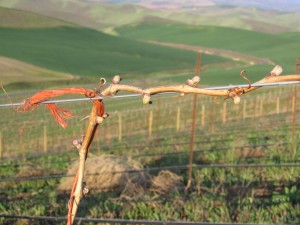That’s what we’re waiting for these days out in the vineyard, for the days to warm and the sap to rise, to see what we’ve got to work with this year. Here’s why: right around Thanksgiving last year, a major freeze rolled through the Columbia Valley and our vineyard on Rock Flour Hill. We were spared the below zero F temperatures vineyards in WA and to the east of us received–the lowest our gauges recorded was 5 degrees F. So far we’ve seen no wood damage that we’ve heard might be the case in WA. But Scott says there’s no guarantee of bud damage, we just have to wait and see for the days to warm up and the sap to start making its rounds, out to the buds and leaves that unfurl from them. We had a similar wait-and-see episode the first year we planted, a deep freeze came in instead of the anticipated first frost at the end of October. Our vines were young, tender, barely hardened off in defense of winter cold, and we were told the vineyard was dead. It wasn’t. But it was a frightening thought, and many months of fret ensued.
On the other side of the country, in upstate New York, my father is also closely watching sap, as he waits for buds to come out, but on sugar maple trees. For him, this signals the end of collecting sap for his maple syrup production–he told me that once the trees bud, the sap becomes soured, and no good. He’s a very small producer of syrup, maybe only a handful of gallons — when it takes 40 gallons of sap to make 1 gallon of syrup, and it’s just him doing the work, who can blame him? When I was young he’d tap the centuries’ old maples out in the front yard of his similar-aged home (used to be an Inn). I think now he uses the younger stands of maple up on the hill where he has his sheep. He still does it the old fashioned way, outside over wood-burning fires, imparting a lovely smokiness to the syrup. He better save me some!
Funny how we’re both in our own sap-watching stories. I guess that’s just what some farmers do: we watch sap.

